I have been asked a lot about what I think about the state of SEO, what others are saying about it, and if I think blog networks have a future. And of course I do! Now more than ever. Google proved that by the massive de-indexing they did to the public ones. And, I am not alone on that thought.
But an even bigger and growing question, what do we do now? First, because it is still really early since the recent Panda and Penguin updates, no one really knows "exactly" what to do (except for Google of course) as so many things have changed but there has been some great analytical data done on it in addition to the case studies I am going to share with you below. My personal favorite is MicroSiteMasters Is SEO Dead write-up on the Penguin, deriving at some interesting conclusions from looking at the data they had. (its a must read!)
I personally have been locked in my office for the last couple of weeks analyzing sites that ARE currently ranking against sites that have fallen and you know what, I have a sickening feeling that Google has played us like a fool. :-( Let's start here.. | | There has been a TON of buzz going around about the what I would like to call the “Valentine’s Shake Down” and even though some people are reporting that their ranking are starting to come back, others are still down a couple spots or so, and others still, blown to the wood shed! So, what happened? On about Feb 7th rankings starting to rumble and it has sent SEO professionals (including me) into a frenzy trying to figure out what the heck was causing the decrease in rankings of seo’ed sites. (And, we still don’t know for sure where the devalue is, but most will agree, there is a devaluing happening somewhere.) So let’s start late last year… Last November, there are numerous reports from bloggers letting us know that they heard Matt Cutts speak and Pubcon and he said that “some of the webspam engineers had been loaned out on other projects but since the completion of most, he is getting them back and there were two big projects they were working on.” He was also reported to say that they will be taking a look at “Exact Match Domain” names and that he thinks right now having an exact match domain is giving a site too much power in the ranks and that this will be revealed in the coming months.
(citation: http://backlinksforum.com/main-backlinks-linkbuilding-discussion/3137-pubcon-matt-cutts.html) So it should be no surprise that… On January 21st Google released a “State of Search” type of blog post that dove into webspam. In short, they said even though they have already made great progress, they “have new efforts underway to continue to improve our search quality.” And.. “we’re evaluating multiple changes that should help drive spam levels even lower, including one change that primarily affects sites that copy others’ content and sites with low levels of original content.”
(citation: http://googleblog.blogspot.com/2011/01/google-search-and-search-engine-spam.html) And then on January 28 Matt Cutt’s further told us on his blog in reference to the above quote, “That change was approved at our weekly quality launch meeting last Thursday and launched earlier this week.” And he went on to say… “The net effect is that searchers are more likely to see the sites that wrote the original content rather than a site that scraped or copied the original site’s content.”
(citation: http://www.mattcutts.com/blog/algorithm-change-launched/) Well, I thought, that is great news! Nobody likes the webspam sites anyway (junk you see in search results) And, most of us who are doing any type of linking don’t want the site we are linking “from” showing up in the rankings and heaven forbid they land on top of the site we are linking “too.” (which sometimes happens if you are linking from an nice authority sites to a long tail keyword) I mean, we are NOT trying to rank THOSE sites so.. check, we’re good! So then on Feb 7th, the shake down became obvious that it may not just be sites with low quality content being targeted, it may also be low quality linking was next on the list. Back in the original January 21 Google blog posts said, “The new classifier is better at detecting spam on individual web pages, e.g., repeated spammy words—the sort of phrases you tend to see in junky, automated, self-promoting blog comments.” (see original site citation above)
Ok, check on that one too as I was glad I didn’t do any of THAT! lol But Backlinksforum.com was buzzing with so much conflicting evidence that a direct pin point on exactly is causing a link devaluation is unclear at best. I just know none of my moneys sites that have been linked to exclusively from my private blog networks were NOT affected, AND, what surprised me most is that I had one of my assistants doing some testing with profile links and xrumer and THOSE money sites were not affected either as they all held their rankings. Hmmm. One of my sites did however drop from #4 to #17 on a major keyword, but I had also used someone else’s link network on it AND the links were not contextual) Hmm. Then on Feb 12, the JC Penny debacle was released to the world in the New York Times. WOW!
(citation: http://www.nytimes.com/2011/02/13/business/13search.html?_r=2&scp=2&sq=jc+penny&st=cse) Bottom lining it, JC Penny was in so many #1 spots that it drew attention to the New York Times and as they investigated their story, it drew the Google’s attention! Weather or not Google did a manual review and de-indexed sites that were contributing to the inflation of their rankings we won’t know for sure, but JC Penny’s rankings have suffered the same sort of ranking drops as many other seo’d sites. Not to the woodshed, but just a couple of spots or more. And, since it has affected the entire SEO community, my bet is on the algorithm change that lowered JC Penny’s rankings not a manual review. Or maybe both, but one thing is for sure, the rest of us got caught in the back wash. lol  Oh and for the most part “Exact Match Domains” are history. There are some exceptions of course, but unless they are a .com and have age and size, they have been pushed back into the nowheresville just for being an EMD. So, the take away is? Google’s WebSpam engineers are baaaaaaack… making our lives interesting again!  | | DID SOMETHING JUST CLICK IN YOUR HEAD? It should of, 'cause the JC Penny thing happened LAST YEAR! I wrote that post Feb 24th, 2011!! And of course that was the Panda 1.0 update and the Article Networks were hit HARD! The SEO community divided on the use of posting articles as a SEO benefit. One year later, Article Network pages still don't appear on page 1 results as they once did, but links are proving to be as beneficial as they ever were in proper link density (more on link density later.) So lesson #1. Deja vu! One year later, the SEO community is taking another beating almost to the day! This time it is blog networks taking the brunt of the hit as everyone turn themselves in when Google sent out those dreaded "Un-natually Linking" emails into webmasters inboxes. We need to remember that THIS is the nature of SEO and not to panic, blame or react until the dust settles. Here is the rundown of the last couple of months as "I" saw it. Jan-Feb, 2012
|  | Unnatural Linking Emails From Google Google sends out in excess of 750,000 "Linking" notices to webmasters boxes and scares the crapola out of even the most savvy SEO'ers. Webmasters turned themselves in and the blog networks started to unravel. At first presuming moles, it is later consistently believed that SEO hosting IPs were the point of entry after webmasters declaration of sites and services they used. Google does what is presumed to be manual review and massive de-indexing of sites used in these services. Google demands that webmasters get rid of these "un-natural links" that are pointing to their sites and the frenzy begins as webmasters panic and start link removal campaigns. | | | | | | Jan 14th | | Panda 3.2 Refresh - | | | | | | Jan 19th |  | New Layout Improvement Update Google introduces new layout update that dials down sites with aggressive ad layouts above the fold and goes almost unnoticed in comparison to the above.
http://googlewebmastercentral.blogspot.com/2012/01/page-layout-algorithm-improvement.html | | | | | | Feb 7th | | I launched SeoLinkMonster with Brad and Matt Callen | | Feb 15 | | We noticed a server of sites de-indexed, we get hammered in forums, we quickly replace sites thinking it was a bad batch of IPs | | | | | | Feb 29th |  | Panda 3.3 Refresh! WOW! This refresh was the most dramatic since 1.0 in my opinion and is when we really started seeing sites drop like bricks. Everyone is scrambling to try and figure out what the devalue is. I stop development on a SEO course I was working on until we could figure out what was going on. | | | | | | March 10th |  | I notice more sites being de-indexed and start monitoring and replacing. It feels like Google is playing whack-a-mole with us as they de-index everything we put up. Customers quit in droves and link removal requests start to come in the masses. | | | | | | March 15th |  | Matt Cutts confirms on twitter that blog networks are on their radar. :-( | | | | | | March 20th |  | BuildMyRank Closes its doors calling it a good run :-( | | | | | | March 23rd | | Panda 3.4 Refresh | | April 5th | | I release update to SeoNitro customers signing a NDA | | | | | | April 18 |  | Negative SEO Case Study Reveled on Traffic Planet
http://trafficplanet.com/topic/2369-case-study-negative-seo-results/ This reveals the possibility that by pointing to many "exact match" anchor links at a site, that site will drop in rankings and opens the doors for much discussion concerning negative seo attacks on competitors. | | | | | | April 19 | | 2012 Panda 3.5 Refresh | | | | | | April 24 |  | Penguin! Penguin Update is launched with an aim at combating WebSpam and gives examples of "keyword stuffing" and "linking schemes." http://googlewebmastercentral.blogspot.co.nz/2012/04/another-step-to-reward-high-quality.html They create a dividing line between black and white hat SEO and it is apparent that anything other than making your site easier to crawl and putting good content on your site is Black Hat. From Matt Cutts "We want people doing white hat search engine optimization (or even no search engine optimization at all) to be free to focus on creating amazing, compelling web sites." …"even no optimization at all…" yeah right, and pigs may just fly one day too! (From Matt Carters Blog in response to that, as it was too good not to repeat! lol) | | | | | | End April to Present |  | The Aftermath An endless amount of outrage, reviews, analysis and water cooler gossip about Google's new approach to SEO (how could they?!?) A couple of great analytic reviews reveal that excessive "exact match" keywords in addition to excessive on-page optimization to are major culprits of the dial down. | | | | | And then... May 10, Google's Matt Cutt's makes a revealing admission... 
(citation: http://searchengineland.com/google-talks-penguin-update-recover-negative-seo-120463) Um, "not about bad link networks?" So even though the blog networks took the brunt of the blame this time around, all those notices were not the result of the blog networks? Wow!! But, it actually makes sense. Blog networks traditionally, and if done right, can't take on a massive amount of customers. I had only a little more than 400 in both SeoNitro and SEOLinkvine Elite so I knew "my" networks weren't responsible for 700,000 notices!! I don't know about BMR, HPRS, or ALNs membership stats but I would be surprised if all of us put together totaled more then 5k customers. I had put that 2 + 2 together a long time ago, but it didn't seem to matter, the damage had been done. We (the collective SEO industry) told on ourselves and the unravelment of the incredible blog network ranking machines were thrust into the cross hairs of Google's de-indexing committee, and we did NOT win. But here is the kicker. Not only did they de-index the sites, they demanded that webmasters have their links taken off of those de-indexed sites before any reconsideration would be done. Now, I scratch my head. Why would they demand links to be taken down if these links were on de-indexed sites that were dead, gone, forgotten, virtually rendered useless in the eyes of Google? Except for the tattle tale element, there was nothing really compelling about it, I mean, surely Google is smart enough to know when a link is on a de-indexed site and rendered useless? Right? But the drill continued over and over, until we all blindly followed the piper and we took down links and then finally entire networks. Mistake? Now I would never want to open the can of worms or even suggest that de-indexed sites can still have some sort of relevance in Google. That would be ludicrous, wouldn't it? And I certainly would not want to get in ANY debate over it, I am still incredibly sore from the forum bashing's and hate mail I have received in the last couple of months over the entire de-indexing debacle the moment we launched SeoLinkMonster! Ughhh. But.. I will say, I do have people in my line up that want those links.. de-indexed or not. Strange right? I thought so until they have showed me examples of sites ranking for amazingly hard gambling keywords with the majority of links coming in from BLOGROLL LINKS on DE-INDEXED SITES!! Yeah, that's right, blogroll links!! Forget that the site is de-indexed, if that isn't enough, they were BLOGROLL LINKS!! (I haven't given blogroll links any credence in years, but I saw it for myself.) 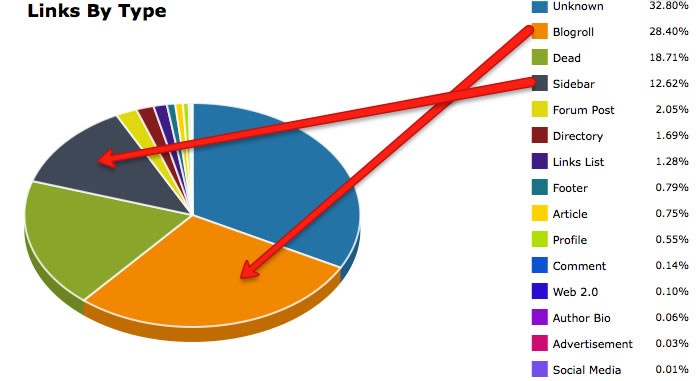
And I checked those links and sure enough, most of them are on de-indexed sites. (I can't publish them here to protect the site owner so you will have to trust me on that one.) Then I thought to myself, well it is true.. whenever we suffered partial de-indexing in the past it NEVER correlated with a drop in rankings. Hmmm So what if it wasn't the de-indexing of the networks that made a lot of these sites drop? Hmmm (I was among everyone that thought the ranking drops of blog network users were because of the loss of links derived from the mass de-indexing. I mean, if the site was de-indexed, the link was as good as gone, right?) Well, just what if.. ..what if it was actually a loss of links from the networks taking down links at customer requests in combination with the "exact match" keyword dial down? (the "exact match" keyword dial down had been coming and getting stronger (or should I say weaker) for a while. I had done an entire write-up on it for my seo mastermind back in Nov, 2011 and had been advising customers to make sure they had a large percentage of URL (brand) links to balance their linking profile for years)
I then wondered if Google still crawled de-indexed sites? Well one way to find out was to go look at the logs of the network sites that I had that had been de-indexed. And to my surprise... they DO! 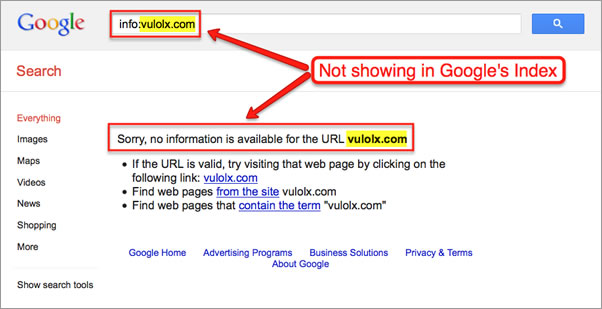
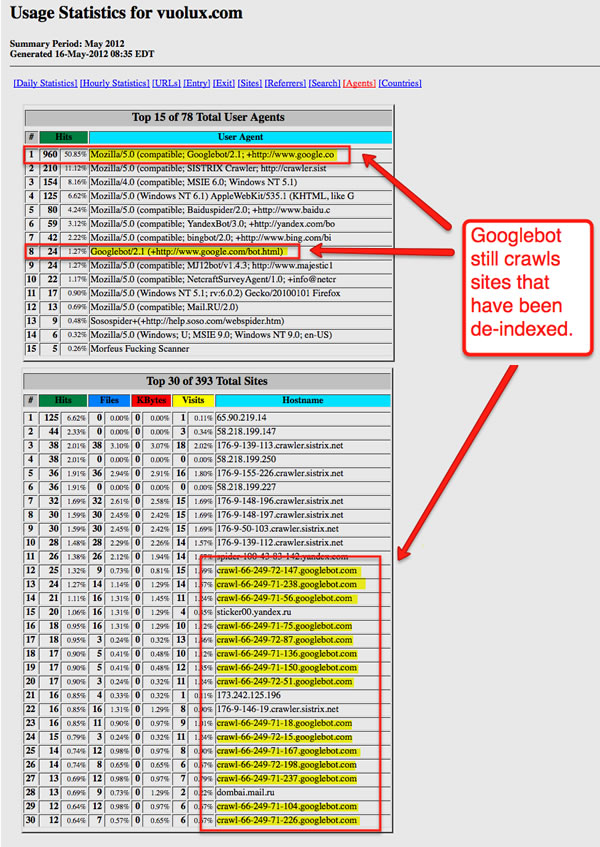
WOW! ok.. This made me start digging a into money sites that had recently dropped in rankings. And what I found was that in the sites that "I" looked at, every single one of them had a higher dead link percentage. (IMPORTANT: a dead link is NOT a link from a de-indexed site, it is a link that is no longer there or the site is not available) Average for dead links is running around 20% and anything with 40% or higher was NOT on the first page for their respective keywords and the ones over 70% were not in the first 100 for their respective keywords. Here are three case studies I did for this article. Each of them in a different market and each had used blog networks, some more then others, but they all had dipped their toes into it. You can see the affected sites on the left have a WAY larger % of dead links (in blue) and the two that dropped into the hundreds on the top right have a huge amount of dead links. IMPORTANT: I want to say this again. Dead links are NOT a link from a de-indexed site, it is a link that is no longer there or the site is not available. The tool I used to pull this information does not decipher if the link is coming from a de-indexed site or not just if the link was THERE or not. 
So what does all this mean? I don't really know, but if we have a site ranking in the gambling industry that left their links up from de-index sites and sites that have dropped because they took those de-indexed links down, that there might be something here, and Google may have played us big time. So, I am testing it. I have created a case study on one of my own sites that ranks respectively in it's market and have just started a linking campaign towards it using ONLY de-indexed sites. I am linking using industry phrases that I am currently NOT ranking for (top 1000) and if I show up for those keywords, then we know that de-indexed sites do play a role in ranking efforts. If I go down in my established rankings, then we know that links from de-indexed sites can be used to negatively seo a site. If nothing happens, then we know de-indexed sites do nothing. (which I am still inclined to think, but I will finish this out. lol.) Lesson #2: Don't Panic! I learned a long time ago to take what comes out of the mouths of Google's distinguished engineers with a discerning ear. Things may not be as they seem, and then again, they may be, but we won't know for sure until we test it. SEO changes all the time and a quick reaction may do you more harm than good. Now with that said, I don't want to leave here with you thinking that the dead links are the ONLY contributing factor to the above sites loss in the rankings. That was something that was just glaring out at me and had to look into further. But, as I studied theses particular sites and the competition that is currently on page one of Google for their respective keywords, in most cases I found the following post panda/penguin off-page disqualifies. - Over 40% of their links were dead: as reported above (not de-indexed, dead as in sites that are NOT crawl-able)
- Social Factors were lower then competition: This means, not as many FaceBook "likes," "shares," Twitter "tweets," or Google+.
- Links were not diversified as much as the competition: (I am seeing a lot of directory, forum, blogroll, footer and sidebar links, go figure lol)
- Abnormally high "exact match" keywords: in what I have looked at it is really hard to come up with a general number as I have seen percentages all over the map, so look at your percentage as compared to your competition whom are ranking above you.
- Lower amount of onesy and twosy links: sites generally get a LOT of strange, varied links as no one thinks the same when linking so this also goes hand with #4. Get your percentage of anchor text that are only used once.
So lets go into the other 4 points a little deeper. Social Factors Let's face it, social factors have finally become a SEO factor. For example, here is an example for Case Study #1 with the keyword being "model ships." 
We see that even though we are not currently ranking for this keyword (and we were previously #2) our site has the most MozTrust and Linking Root Domains score and has the second best page authority, but is low on social aspects and especially low on "Times Shared on FaceBook" in comparison with the sites now ranking on page 1. On Case Study #2 with the keywords of "moving companies" and "mover reviews" for the example on the left, again our two sites that have tanked are very low on social signals. 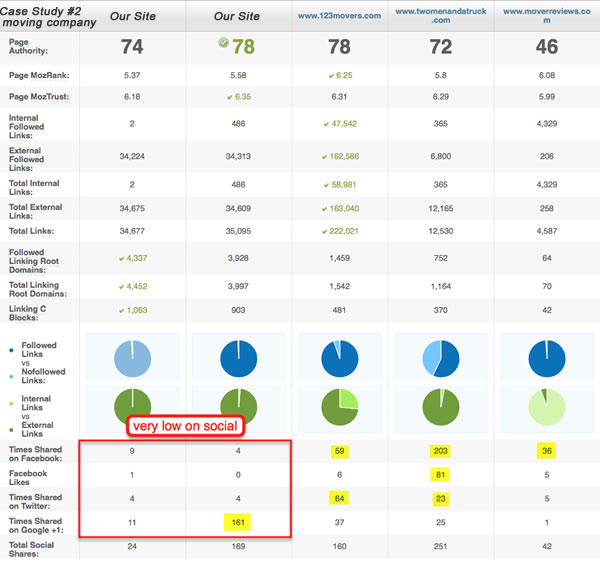
While this site out does everyone in Google+ in the group, our Facebook shares and likes along with tweets are the lowest. In Case Study #3 it is important to note this site only dropped to the bottom of page two so the affects of Panda/Penguin were not as severe, but as we all know, going from the top of page one to the bottom of page two is like going to page 1000 traffic wise, so this drop is incredibly severe to the pocket book and worth analyzing the partial drop. 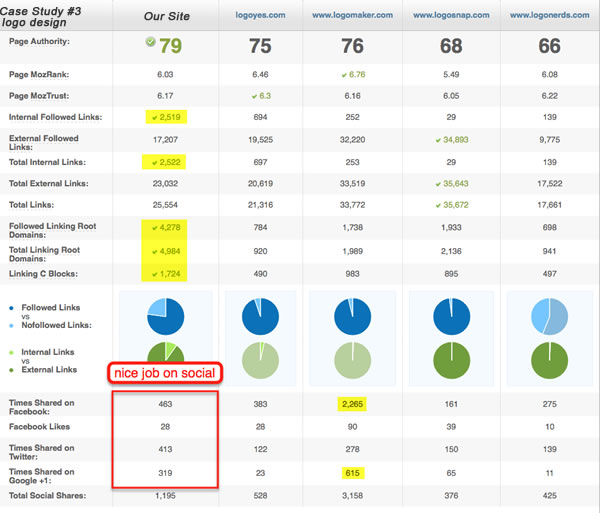
And as you can see, we have the best page authority and out match in almost every area and even have done a nice job in the social arena, so it may be a hint to why this site only was set back to page two. Link Type Diversity So, lets stay with this site and Case Study #3 for a moment as we look into reason number three why sites tanked, "Link Type Diversification." We can see that this site did a pretty good job as compared to the other two case studies. 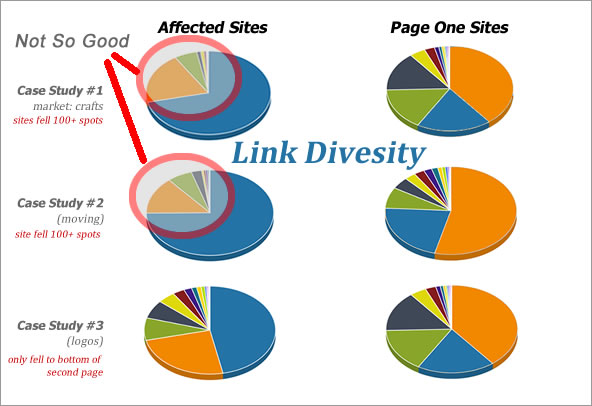
And in every case, sites remaining on page one have a great deal of link type diversity. And I look at a lot of these links, and believe me, they are coming in from "low value sites!" I hear a lot of SEO guru's telling people to try and get rid of these low value incoming links, but I say, the internet is mostly made up with low value links, de-indexed included, so chasing people down to have them stop linking to you may not be the best use of your time. Just sayin'. LOL Lesson #3: Low Value Sites Make Up the Majority of the Internet The internet is made up with low value links just by being the nature of the internet, so get links from them all, i.e. from article and web directories, forums, sidebar and blogroll (didn't think I would ever say that!! lol) blog networks, press releases networks, social, web 2.0, images, profiles, comments, etc. And yes I want the authority links too, but might be funny if I only have PR5s pointed at me! Anchor Text And now we get so anchor text and look at Disqualifiers #4 and #5 as they go hand-in-hand. This is probably the biggest post Panda/Penguin disqualifier as in most sites we will have researched did not diversify their link anchor density and were hit hard this go around with the "exact match" dial down. Sticking to Case Study #3, let's look at the exact match anchor text ratio for the term "logo design" in comparison to page 1 sites. 
We find that it is indeed the highest, but not totally out of the ball bark considering that LogoYes.com which is number 1 for the term pretty high as well compared to the others. But the affected site has only 6.60% brand of incoming links (i.e., anything with their name or URL in it) while the other page 1 sites have them into the 26-35%. That says a lot. But also noteworthy is that the affected site IS ranking on page 1 for the two terms that I show that have a lower exact match anchor density. What is really great about the affected site is that it has a lot of onesy and twosy links that are all combined in the "other" category, so they are getting a lot of the "family" terms which we are finding important. Another interesting thing about this case study is LogoMaker has an incredibly low exact match density for the term "logo design" except in the alt tag, which is the image descriptor. Hmm. As we go up to Case Study #2 we find that our affected sites have VERY LITTLE brand incoming links. Ouch! This seems so drastically low that it is probably affecting a couple of the other low-density terms that I point out under site 2. 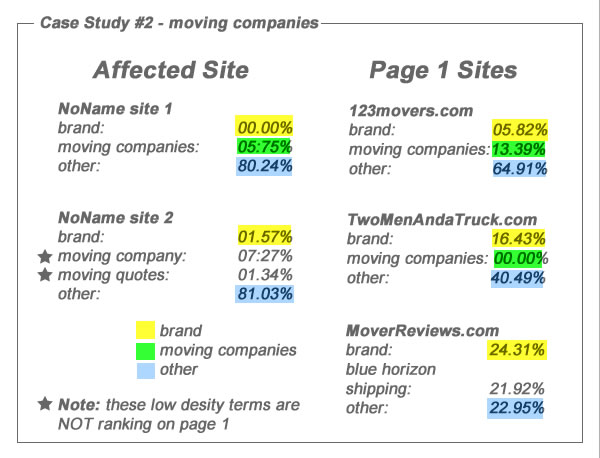
Another interesting thing about this is that TwoMenAndATruck.com have no (well trace amounts) of exact match incoming links for "moving companies" yet they rank on page 1 for it. hmmm
And look at MoverReviews.com with that HIGH exact match percentage for "Blue Horizon Shipping" where it ranks number 2. hmmm (I would have to look at the other sites ranking for that term to see if that was high or not, but with the nice brand linking they have done, (and yes they rank number 1 for "mover reviews") they are looking in decent shape even though all the other metrics on our comparison charts were low.) Lesson #4: Market/Keyword Sensitivity This just shows me that EACH market/keyword is going to be different and I will have to research each one to understand what it will take to out rank my competition in that arena. Case Study #2 was a little more difficult to do since I had two sites and different keywords, but hopefully it provided value as we look at the case studies as a whole. Which leads us back to Case Study #1 for "model ships" and again our affected site has virtually no brand links coming in. 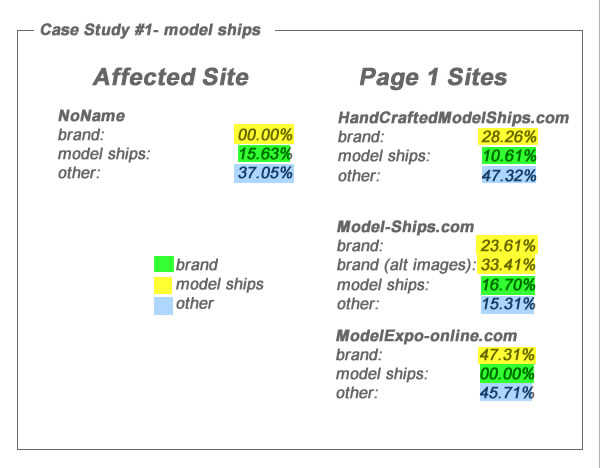
And again we see a site ranking (modelexpo-online.com) for a term with a trace amount of exact matches for this keyword that it is ranking on page 1 for. But this site has a ton of brand linking coming in and a lot of onesy and twosy links making it a very rounded site. Lesson #5: Link Brand it! It is natural for branded links (URLs) to come into your site, just look how many times I have done it in this article. And from what I just saw in these case studies, it is now become critically important. So, besides the lessons that I pointed out along the way in this article, what are some of the solutions that can be taken for each of these disqualifiers. And this isn't to say that this takes the place of great marketing and creating great content that people want to link to and like! LOL, I know you are already doing that. So if you are suffering from any of our disqualifiers, here is what you can do.. - Dead Links: as reported above (not de-indexed, dead as in sites that are NOT crawl-able)
-Replace links as fast as possible: now this is a touchy subject since how can you replace links and not violate Google's guidelines? You can't. So take this advice as your tolerance level will handle. But for me, I am joining blog networks, creating directory listings, getting blog and forum comments and profile links, and yes, even blogroll links, and I am doing it in MASS for sites that lost in MASS. If your site didn't lose as many, then just get a few and you can be more selective.
-Perhaps stop asking for your links to be taken down? (just sayin')
- Social Factors: Tweets, Likes, Shares and Pluses
-Ask your friends and family to like you! LOL -Put out great content and ask people to share and tweet (like I do below ;-)
-Can use automated services like Socialadr
- Link Diversification: Links from multiple sources and areas on page.
-This is almost the same answer as for Dead Links.
-Join blog networks with blog roll linking
-Use Directory Maximizer for automated site directory submissions
-Post Articles in article Directories
-Put out Press Releases
-Pre-Panda/Penguin I would of said head on over to Fiverr.com and get yourself some diversification, but I am kind-of hesitant cause I don't know if Google is watching things over there or not. I have no proof, just a gut reaction, so use your best judgement.
- Excess "Exact Match" Link Density: Too much of the same keyword!
-You will need to do your competitive research so you can find out what is TOO high in your market/keyword. The groovy little tool I used for this is called LinkDensity that let's you compare link density metrics.
-Do everything mention above about getting links, but BRAND, BRAND, BRAND!!
-I am NOT going to even put an exact match keyword out there right now unless it is in the SAME anchor as my BRAND, i.e., SeoNitro.com SEO Training. ;-)
- Onesy and Twosy Links: Links where anchors do not repeat in your link density profile.
-Search on Google for your keyword and scroll to the bottom and find what Google considers to be "family" match keywords
-Go to a thesaurus and find synonyms of your keyword to use in you linking campaigns
-Here is a sneaky thing I am doing, LOL. You know all that research I just did on my competitors? Well I am taking their "other" keywords and using THOSE (except for brands) to insert into my linking campaigns. hee hee One More Thing.. ..worth mentioning is On-Page factors are back and looking like Latent Semantic Indexing has finally come into play. I have not tested this, but have "heard" about it from a couple different sources (from people whom I consider know what they are talking about) and that this is helping sites that suffered and also ranking new sites at great speed. The idea that is being presented is putting NEW content on your site using nothing but family keywords and synonyms that are used in your market and for the keyword you want to rank for and then linking to these new pages using brand or onesy, twosy types of links, which of course, are family anchors. I also watch a great webinar that Matt Carter did with a guy who has been testing on-page factors related to Panda Recovery and seems to have narrowed it down to.. 1) Article Inner Linking 2) Writing ON TOPIC rather then keywords 3) Bounce Rate 4) User Experience
Which seems to go hand-in-hand with what I am discovering with my off-page tests. It is a very good webinar and I recommend you watch it for more on-page guidance. He does sell a product at the end but don't let that keep you from getting the goods he is delivering on the call. I hope this study was helpful for you. If you liked it, please pass it around. I could use some coveted shares, likes and tweets! :-) And, if you would like to spend a weekend with me going over this type of stuff in addition to learning how to build your own quality link network, then head on over here and reserve a seat. I also have packages where I will build your private link network for you so you can have FULL control over your linking. "A private blog network is still something very powerful if used correctly. Building one does take some time but once you have a few high pr blogs that you can use for link juice (and you are the only one who’s using it) chances are you will not get de-indexed as the site in your network won’t look any different from any other website on the internet."
http://internetmarketinghustle.com/seo/public-blog-networks-are-dead-what-should-we-be-doing-now cheers, Dori Friend
p.s. don't forget to comment below and let me know if you know of anything working or not working post Panda/Penguin as we are ALL interested. :-) p.s.s. get on the update list to find out if Google did indeed make a fool of us when the test results come back from my de-indexing site valuation.
|